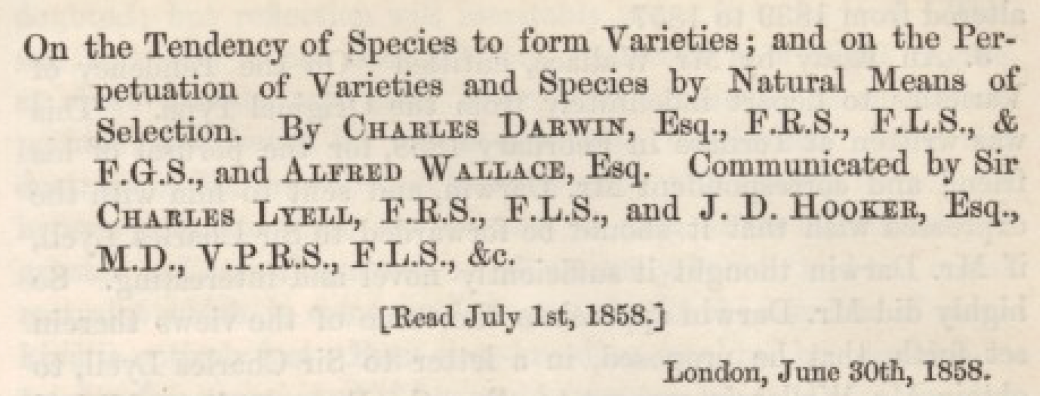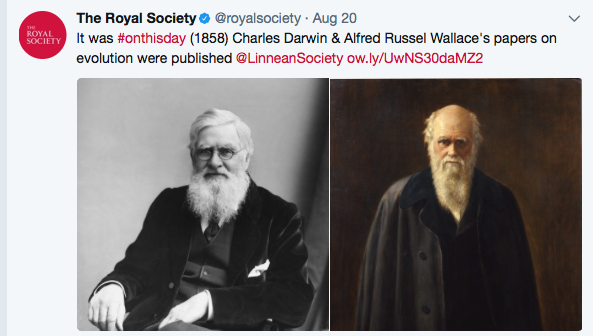This month [see footnote 1] marks the anniversary of the famous 1858 Darwin-Wallace publication on natural selection published in the Journal of the Proceedings of the Linnean Society of London, Zoology (PDF here). [Note that it was read at a meeting of the Linnean Society on 1 July and published a mere 7 weeks later!] This joint paper ushered in what is arguably the greatest scientific and cultural revolution in human history, a fine example in support of Thomas Kuhn’s (1962) argument that scientific revolutions are driven by ideas. Last week I presented, on this blog, some evidence that tools also fuel revolutions in science.

How did the study of birds figure into Darwin and Wallace’s arguments? We know from Darwin’s many books, and much of Wallace’s writing, that both men studied birds and used examples from birds to illustrate and support many—if not most—of their ideas. This 1858 paper marks the beginning of the association between birds and natural selection. We cannot argue that the study of birds was in any direct way responsible for this scientific revolution but there can be no doubt that this revolution forever influenced how we study birds.
In this publication, Darwin first uses birds as an example of Malthus’s ideas about population:
Suppose in a certain spot there are eight pairs of birds, and that only four pairs of them annually (including double hatches) rear only four young, and that these go on rearing their young at the same rate, then at the end of seven years (a short life, excluding violent deaths, for any bird) there will be 2048 birds, instead of the original sixteen. As this increase is quite impossible, we must conclude either that birds do not rear nearly half their young, or that the average life of a bird is, from accident, not nearly seven years. Both checks probably concur. The same kind of calculation applied to all plants and animals affords results more or less striking, but in very few instances more striking than in man
He then introduces his arguments about sexual selection that he will work on for another 13 years before publishing in 1871 in Descent of Man.
These struggles are generally decided by the law of battle, but in the case of birds, apparently, by the charms of their song, by their beauty or their power of courtship, as in the dancing rock-thrush of Guiana. The most vigorous and healthy males, implying perfect adaptation, must generally gain the victory in their contests. This kind of selection, however, is less rigorous than the other; it does not require the death of the less successful, but gives to them fewer descendants. The struggle falls, moreover, at a time of year when food is generally abundant, and perhaps the effect chiefly produced would be the modification of the secondary sexual characters, which are not related to the power of obtaining food, or to defence from enemies, but to fighting with or rivalling other males.
Wallace also uses birds to illustrate Malthus’s ideas, though, unlike Darwin, he never refers directly to Malthus in his essay:
For example, our own observation must convince us that birds do not go on increasing every year in a geometrical ratio, as they would do, were there not some powerful check to their natural increase. Very few birds produce less than two young ones each year, while many have six, eight, or ten; four will certainly be below the average; and if we suppose that each pair produce young only four times in their life, that will also be below the average, supposing them not to die either by violence or want of food. Yet at this rate how tremendous would be the increase in a few years from a single pair! A simple calculation will show that in fifteen years each pair of birds would have increased to nearly ten millions! whereas we have no reason to believe that the number of the birds of any country increases at all in fifteen or in one hundred and fifty years. With such powers of increase the population must have reached its limits, and have become stationary, in a very few years after the origin of each species. It is evident, therefore, that each year an immense number of birds must perish—as many in fact as are born; and as on the lowest calculation the progeny are each year twice as numerous as their parents, it follows that, whatever be the average number of individuals existing in any given country, twice that number must perish annually,—a striking result, but one which seems at least highly probable, and is perhaps under rather than over the truth.
Finally, I particularly like the following passage from Wallace’s contribution to this publication, where he makes an ecological argument for the abundance of the passenger pigeon:
Perhaps the most remarkable instance of an immense bird population is that of the passenger pigeon of the United States, which lays only one, or at most two eggs, and is said to rear generally but one young one. Why is this bird so extraordinarily abundant, while others producing two or three times as many young are much less plentiful? The explanation is not difficult. The food most congenial to this species, and on which it thrives best, is abundantly distributed over a very extensive region, offering such differences of soil and climate, that in one part or another of the area the supply never fails. The bird is capable of a very rapid and long-continued flight, so that it can pass without fatigue over the whole of the district it inhabits, and as soon as the supply of food begins to fail in one place is able to discover a fresh feeding-ground. This example strikingly shows us that the procuring a constant supply of wholesome food is almost the sole condition requisite for ensuring the rapid increase of a given species, since neither the limited fecundity, nor the unrestrained attacks of birds of prey and of man are here sufficient to check it.
…and continues with ideas about the adaptive significance of migration and factors that influence the relative abundance of species:
In no other birds are these peculiar circumstances so strikingly combined. Either their food is more liable to failure, or they have not sufficient power of wing to search for it over an extensive area, or during some season of the year it becomes very scarce, and less wholesome substitutes have to be found; and thus, though more fertile in offspring, they can never increase beyond the supply of food in the least favourable seasons. Many birds can only exist by migrating, when their food becomes scarce, to regions possessing a milder, or at least a different climate, though, as these migrating birds are seldom excessively abundant, it is evident that the countries they visit are still deficient in a constant and abundant supply of wholesome food. Those whose organization does not permit them to migrate when their food becomes periodically scarce, can never attain a large population. This is probably the reason why woodpeckers are scarce with us, while in the tropics they are among the most abundant of solitary birds. Thus the house sparrow is more abundant than the redbreast, because its food is more constant and plentiful,—seeds of grasses being preserved during the winter, and our farm-yards and stubble-fields furnishing an almost inexhaustible supply. Why, as a general rule, are aquatic, and especially sea birds, very numerous in individuals? Not because they are more prolific than others, generally the contrary; but because their food never fails, the sea-shores and river-banks daily swarming with a fresh supply of small mollusca and crustacea.
Most biologists have read little of what Darwin and Wallace wrote, in part because they think it’s out of date (it’s not) and both convoluted and a bit dry to read (it is, but not uninteresting). If you read nothing else written by these two men, this initial publication, with essays by both of them, is well worth the few minutes invested to read and, particularly, to think about the revolution they started 159 years ago.
References
Darwin CR (1871) The Descent of Man and Selection in Relation to Sex. John Murray, London.
Darwin CR, Wallace AR (1858) On the tendency of species to form varieties; and on the perpetuation of varieties and species by natural means of selection. Journal of the Proceedings of the Linnean Society of London, Zoology 3:46-50
Kuhn TS (1962) The Structure of Scientific Revolutions. University of Chicago Press, Chicago.
Footnote
- There seems to be some confusion about the actual date. Wikipedia says “the papers appeared in print on 20 August 1858” as does the Royal Society’s twitter feed, which (strangely) links the reader to Wikipedia (see below). Darwin Online, however, says “August 30th, when it appeared in print”.
